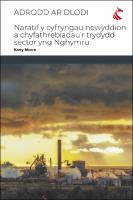Adrodd ar Dlodi
Naratif y Cyfryngau Newyddion a Chyfathrebiadau’r Trydydd Sector yng Nghymru
Abstract
This book presents an in-depth, systematic investigation of the reporting of poverty in Wales, discussing findings from a two-year research project funded by the ‘Exploring the Narrative Coalition’ (a group of 10 Wales-based third sector organisations), the ESRC, and Cardiff University. Examining how poverty news is covered in the English and Welsh languages across broadcast, print and online news, it provides a detailed insight into current journalistic and communications practices on a crucial issue facing Wales. In the wake of a decade of austerity policies, with official measures confirming experiences of poverty and destitution are increasing, the book offers a timely intervention, critically investigating mainstream media narratives on poverty and how these are shaped. The book is based on original research conducted in 2016-7, in a highly eventful period that included the Tata Steel crisis in Port Talbot, South Wales, the Welsh Government elections and the referendum campaign on the UK’s membership of the European Union. It addresses how poverty was framed in such nationally significant news about politics, business and economics, as well as more local, personal or community-focused stories about livelihoods and social issues. A quantitative analysis of the key characteristics of coverage across different media types provides a detailed evidence base for understanding how poverty news was represented. This includes examining the major contextualizing themes, social groups and geographical locations most frequently covered, the causes and consequences of poverty, and sourcing. It demonstrates how Wales-based media coverage differs from more negative reporting typical of some sections of the UK national press, especially in terms of stigmatizing discourses surrounding unemployment and welfare. However, important questions are identified about how news narratives convey meaning and, especially, disconnections between the coverage of macro-economic trends or events and their consequences in the lives of ordinary people. Additionally, the book explores why poverty news coverage is constructed in the way that it is, using findings from detailed interviews with journalists and editors about their practice. Through the lens of professional values and experiences, the book examines the challenges thought to affect poverty reporting. Key issues include the contraction of resources and specialist expertise allocated to social affairs journalism, the difficulties of identifying and reaching potentially vulnerable groups across Wales and representing case studies fairly and ethically. A parallel set of interviews conducted with third sector professionals about their engagement with news media and communications practices provides a further insight into the production of poverty news. Here, the pressures in reporting poverty are seen from a different perspective, where seeking to influence the coverage of poverty and respond to news demands can elicit professional tensions between journalists and the third sector and/or productive cooperative relationships positively impacting news narratives. In providing a detailed picture of how and why poverty news narratives are shaped as they are, the book aims to provide an evidence base informing more meaningful, representative and accurate poverty reporting in Wales.
Keywords
Cyfathrebu’r trydydd sector; Newyddiaduraeth; Anghydraddoldeb cymdeithasol; TlodiDOI
10.18573/book5Publisher
Cardiff University PressPublisher website
https://cardiffuniversitypress.org/Publication date and place
Cardiff, 2020Classification
Cultural studies
Media studies
Sociology
News media and journalism


 Download
Download